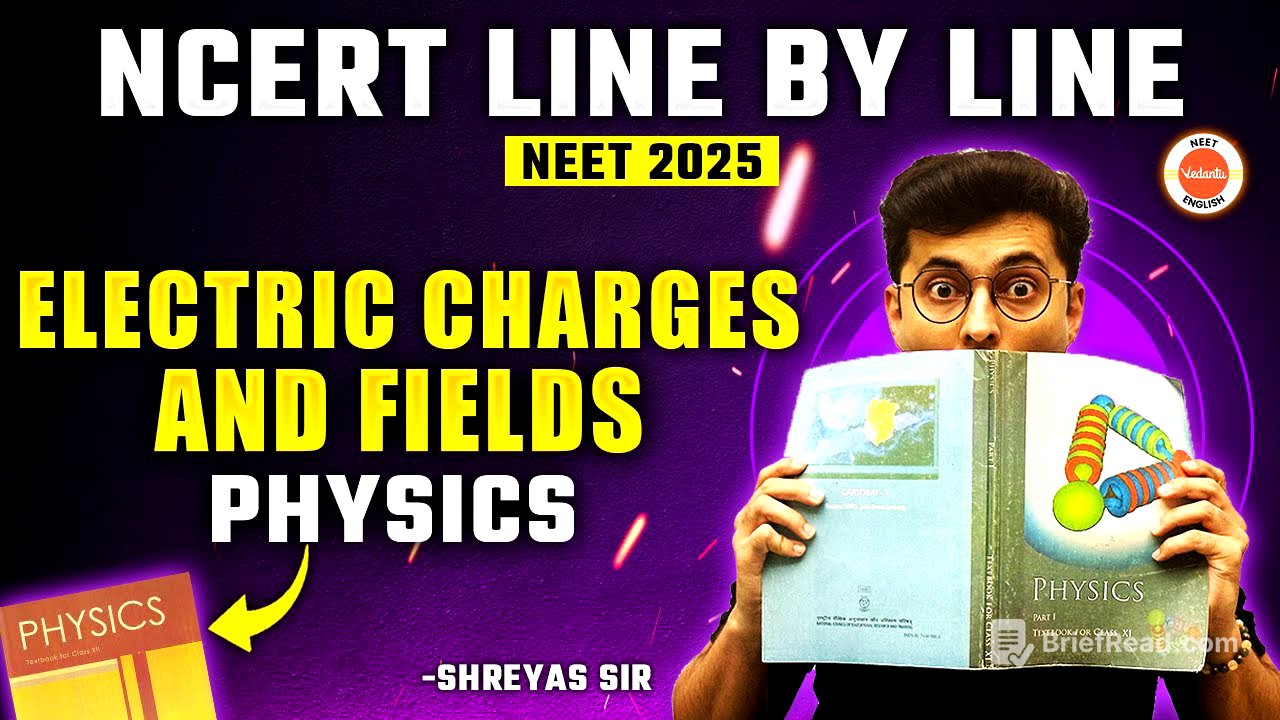TLDR;
This lecture covers the fundamentals of electric charges and fields, including the concept of charge, Coulomb's law, electric fields, and electric flux. It explains the properties of electric charges, the behavior of conductors and insulators, and the principles of superposition. The lecture also discusses the significance of electric fields and their relationship to electric forces.
- Introduction to Electric Charges and Fields
- Coulomb's Law and Electric Forces
- Electric Fields and Electric Flux
- Properties of Electric Charges
Introduction [0:03]
The lecture begins with an introduction to the chapter on electric charges and fields, highlighting its importance for both board exams and NEET. The chapter covers the understanding of charges, the forces they apply, the concept of electric field and flux, dipoles, and Gauss's law with its applications. The discussion starts with the concept of charges, tracing back to ancient observations of electric forces and static electricity phenomena like sparks from clothes and attraction of paper bits. Static electricity, the focus of the chapter, involves charges that do not move.
Concept of Charges [2:39]
The concept of charge is introduced as a fundamental property causing electric forces and phenomena. Historically, the Greeks were credited with early observations of materials attracting light objects when rubbed. Rubbing objects together, like a glass rod with silk, results in electrification, where charges of one kind transfer to the other, leading to one becoming positive and the other negative. This electrification process involves electrons being knocked out and moving to other atoms. Atoms that gain electrons become more negative, while those that lose electrons become more positive.
Electroscope and Conductors/Insulators [11:25]
An electroscope is a device used to detect the presence and amount of charge on a body. It consists of a metal rod in a box with thin leaves attached at the bottom. When a charged body touches the metal knob, charges flow through the rod to the leaves, causing them to repel each other. The degree of divergence indicates the amount of charge. Substances are classified as conductors or insulators based on their ability to conduct electricity. Conductors allow electricity to pass through them easily, while insulators do not. Metals, humans, animals, and the Earth are good conductors due to the presence of free electrons, while non-metals like glass, plastic, and wood are insulators.
Properties of Charge [17:37]
Charges can be positive, negative, or neutral. Protons have a positive charge, electrons have a negative charge, and neutrons have no charge. The three major properties of charge are addition, conservation, and quantization. Addition of charges means that the total net charge is the algebraic sum of individual charges, considering their signs. The total charge is conserved, meaning it cannot be created or destroyed in an isolated system. Quantization of charge states that every charge is an integral multiple of a basic charge, the smallest charge possible, which is 1.6 x 10^-19 Coulombs.
Quantization of Charge and Examples [22:48]
The principle of quantization of charge dictates that any charge is a multiple of the elementary charge (e), where e is approximately 1.6 x 10^-19 Coulombs. The quantization of charge was suggested by Faraday and experimentally demonstrated by Millikan. Although charges are quantized, in day-to-day activities, the quantization principle is not significant due to the large number of electrons or protons involved. The SI unit of charge is the Coulomb (C), defined as the charge flowing through a wire in 1 second for a current of 1 Ampere.
NCERT Examples [31:25]
Two examples from the NCERT textbook are discussed. The first example calculates the time required to accumulate a total charge of 1 Coulomb on a body if 10^9 electrons move out of it every second, resulting in 198 years. The second example calculates the total positive and negative charges in a cup of water (250g), which amounts to approximately 13.38 million Coulombs, highlighting that even small amounts of matter contain huge amounts of charge, but they are electrically neutral due to equal amounts of positive and negative charges.
Coulomb's Law [39:53]
Coulomb's law is a quantitative statement about the force between two point charges. The force varies inversely as the square of the distance between the charges and is directly proportional to the product of the magnitudes of the two charges. The force acts along the line joining the two charges. The formula for Coulomb's law is F = k * q1 * q2 / r^2, where k is Coulomb's constant, which is approximately 9 x 10^9 Nm^2/C^2.
Coulomb's Law Constant and Vector Form [44:59]
The Coulomb's constant (k) is also expressed as 1 / (4πε₀), where ε₀ is the permittivity of free space, with a value of approximately 8.85 x 10^-12 C^2/Nm^2. Permittivity indicates how much electric force is permitted in a medium. The vector form of Coulomb's law is discussed, emphasizing that the force vector has both magnitude and direction. The force on charge 2 due to charge 1 is given by F21 = k * q1 * q2 / r21^2 * r21_hat, where r21_hat is the unit vector pointing from charge 1 to charge 2.
Comparison of Coulomb's Law and Gravitation [58:35]
Coulomb's law and Newton's law of gravitation have similar mathematical forms. A comparison of the electric and gravitational forces between an electron and a proton reveals that the electric force is significantly stronger. The ratio of the electric force to the gravitational force is approximately 2.3 x 10^39. Despite the small magnitude of the electric force, the acceleration produced is very large due to the small mass of electrons and protons.
Examples of Applying Coulomb's Law [1:04:31]
A charged metallic sphere suspended by a nylon thread is brought close to another charged metallic sphere. When both spheres are touched by identical uncharged spheres, the charges are distributed equally. The new force between the spheres is calculated, showing that the electrostatic force remains unaltered. The principle of superposition is introduced to find the net force on a charge due to multiple charges by adding the individual forces vectorially.
Superposition Principle and Examples [1:08:29]
The principle of superposition states that the force on one charge due to another is unaffected by the presence of other charges. The total force on any charge is the vector sum of the forces due to all other charges. Examples are provided to illustrate the application of the superposition principle in systems with multiple charges, such as finding the force on a charge placed at the centroid of an equilateral triangle and analyzing forces in a triangle with both positive and negative charges.
Electric Field [1:18:56]
The concept of the electric field is introduced as the aura or signal that a charge sends out, influencing other charges in its vicinity. The electric field due to a point charge is given by E = k * Q / r^2, where Q is the charge and r is the distance from the charge. The electric field is a vector quantity, and its SI unit is Newton per Coulomb (N/C). A charge produces an electric field everywhere in the surrounding space, and when another charge is brought into that field, it experiences a force.
Electric Field Definition and Properties [1:26:54]
The electric field is formally defined as the force per unit charge, E = F/q, where q is a test charge. The test charge is made negligibly small to avoid disturbing the source charge. The electric field is independent of the test charge and depends only on the source charge and the distance. For a positive charge, the electric field is directed outward, while for a negative charge, it is directed inward. At equal distances from a charge, the magnitude of the electric field is the same, forming a sphere around the charge.
Superposition of Electric Fields [1:34:47]
The superposition principle applies to electric fields, where the resultant electric field at any point is the vector sum of the electric fields due to all individual charges. The electric field varies from point to point in space, depending on the location relative to the charges. The significance of the electric field is discussed, highlighting its role in characterizing the electrical environment of a system of charges and understanding the time delay in the effect of motion of charges.
Significance of Electric Field and Examples [1:40:01]
The electric field is significant because it provides a complete understanding of the system of charges, even without the presence of another charge. The effect of any motion of a charge on another is not instantaneous, and there is a time delay due to the finite speed of light. An example is presented involving an electron falling through a uniform electric field, and the time of fall is calculated. The time taken for the electron and proton to fall through the same distance is different due to their different masses, contrasting with free fall under gravity where mass is not a factor.
Electric Field Examples and Introduction to Electric Field Lines [1:51:20]
Two point charges are placed at a certain distance apart, and the electric field is calculated at different points (A, B, and C) relative to the charges. The electric field at each point is determined by vector addition of the fields due to the individual charges. The concept of electric field lines is introduced as a way to visualize and understand the behavior of charges in the vicinity of a charge.
Electric Field Lines [1:58:30]
Electric field lines are imaginary lines that represent the direction and strength of the electric field. The density of field lines indicates the strength of the field, with closer lines indicating a stronger field. The number of field lines per unit cross-sectional area perpendicular to the lines determines the field strength. The concept of solid angle is introduced to explain the relationship between the number of field lines and the electric field strength.
Solid Angle and Properties of Electric Field Lines [2:04:26]
The solid angle is used to explain that the electric field strength has a 1/r^2 dependence. Properties of electric field lines are discussed, including that they never intersect each other. Configurations of electric field lines are shown for positive and negative charges, as well as for systems of two charges. Field lines always start from positive charges and end at negative charges, or at infinity if there is a single charge. Electric field lines are continuous curves without any breaks in a charge-free region and do not form closed loops.
Electric Flux [2:14:19]
Electric flux is introduced, drawing an analogy to fluid mechanics where flux represents the flow rate of a liquid. Electric flux is directly proportional to the number of field lines passing through an area. The orientation of the area affects the magnitude of the flux. The area is defined as a vector quantity, with the vector being perpendicular to the area. The electric flux is defined as the dot product of the electric field and the area vector: Φ = E · A = EA cos θ. For closed surfaces, the area vector pointing outward is considered positive, while the one pointing inward is negative.









